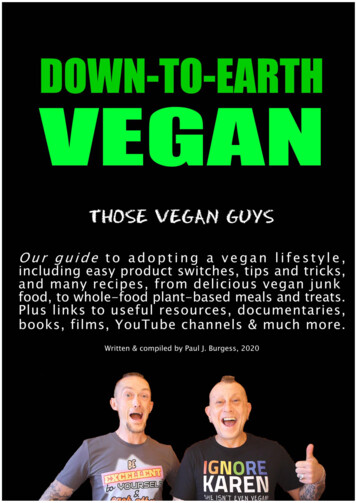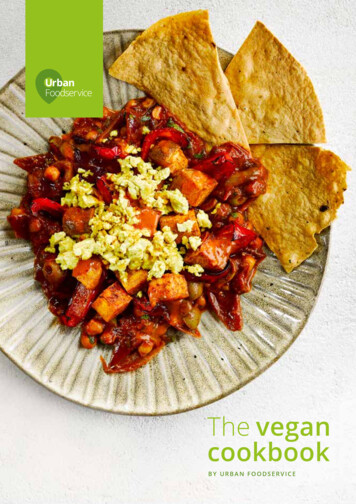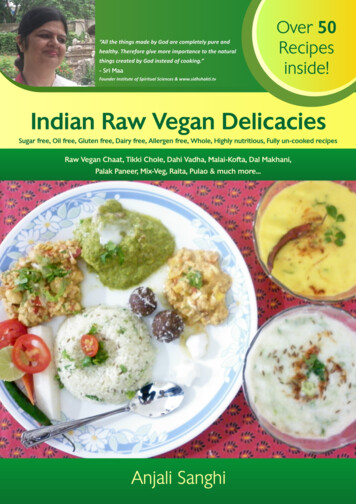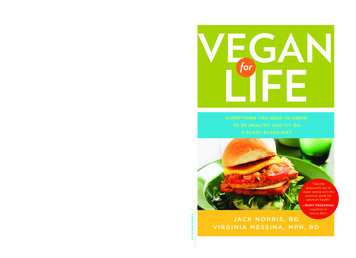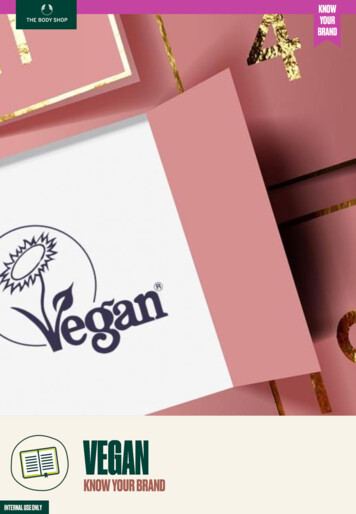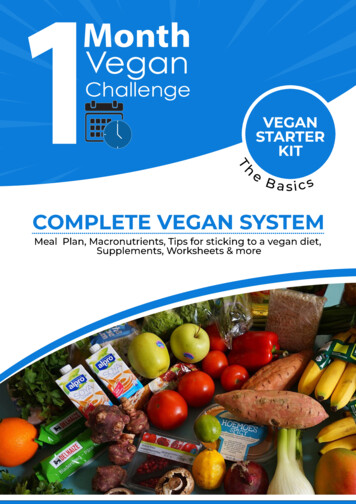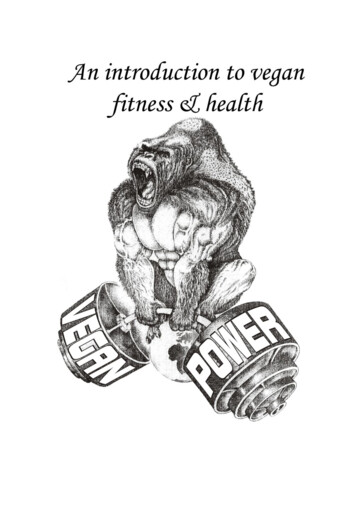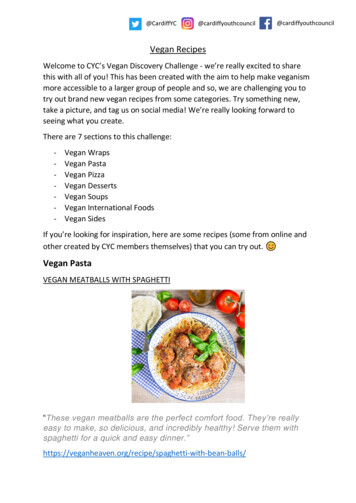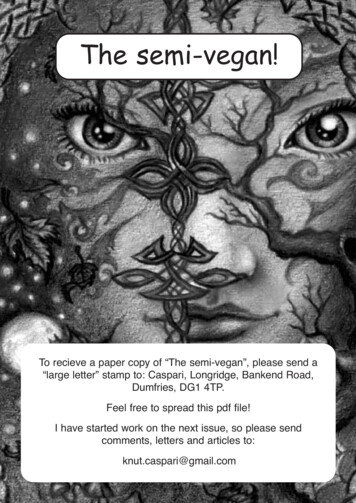
Transcription
The semi-vegan!To recieve a paper copy of “The semi-vegan”, please send a“large letter” stamp to: Caspari, Longridge, Bankend Road,Dumfries, DG1 4TP.Feel free to spread this pdf file!I have started work on the next issue, so please sendcomments, letters and articles to:knut.caspari@gmail.com
FruitarianismVarious well-respected health educators have,in the past, seemingly advocated a pure fruitdiet, in favour of all other diets. I am writing thisarticle as I feel that, not only are the generalpublic at risk, but that they also may fall foul toother health educators authors who are alsogiving what appears to be misleading dietaryadvice.Text: Dr Gina Shaw, MA AIYS (Dip. Irid.)Please be sure that I am not in any way sayingthis in a superior way, more in a motherlymanner! In my practice, I have come acrossmany people who are very influenced byinternational health educators, both deceased andnow active and who have decided to adopt purefruit diets to their own severe detriment at verycostly prices, and I feel that I must warn thosewhom I associate with to be very cautious as to howhealth information is interpreted and indeedwhether to take this information on board for theirown health. I am not in any way condemning a rawfood diet.Fruitarianism, taken literally, with the exclusionof nuts, seeds, sprouts, greens and other vegetablesis not a nutrient-sufficient diet and will result, in thelong-run, in severe malnutrition problems andmaybe even death.Diet, of course, is a matter of personal choice andI am not disagreeing with people who spend amatter of a few days or even two or three weekspurely on fruits, juices or the like. However, it mustbe noted that our individual protein needs must bemet in order for us to function adequately andhealthily and to ensure we do not run into otherdeficiencies too, such as a vitamin B12deficiency. Protein literally means to come first andit certainly needs to! Protein is essential for growth,repair and maintenance of our body and, as such, isa vital nutrient. It can be met perfectly well bysupplying ourselves with raw nuts, seeds and rawvegetables (in adequate proportions). So too, mustour mineral needs be met, and again this willusually not be met by a fruit diet alone (certainlynot on commercial fruit which tends to be of poorquality). Dr Vetrano, a highlyesteemed American hygienicpractitioner has recently beenwarning raw-fooders to make surethey eat sufficient nuts and seedsin their diets in order to meet theirprotein requirements and I applaudher for what she is doing. Onenotable, prominent and wellrespected health educator andnatural hygienist may have notonly endangered, but also lost hisown life in order to stick to hisown ideals. We must take the timeto study the diets of our closestrelatives, and we will find thattheir are no primates in the wildwho consume solely of fruits. Thiswill generally give us a goodindication of what our natural dietsshould comprise!If you would like more informationvisit: www.vibrancyuk.comMy beautiful kitchen!By: Tone Lund BerleThe semi-vegan
Editor:Knut CaspariContributors:Rebecca BurkePolly ButtonsSophie Christopher-BowesAmanda Hawkins (page 19)Tone Lund BerleLiz MackenziePete RyanDr. Gina ShawIshai SilencioSarah 2From the editorThis is my first issue. I hope you like it, and would like to help makeit even better.Text: Knut CaspariYou may be surprised to learn that you can subscribe for free, butthe print cost is only 32p per copy. It actually costs more to postthe magazine, than to print it!But you may be wondering how it is funded? The funds for this issue,have come from the sale of the Norwegian books on page 29. This cannotlast forever, but with a few supporters it can be extended a few issues.Cover:Janne EikebladIf you liked the cover, youmight wish to visitt herwebsite: natursamfunn.noBe a supporter!Address:Knut Caspari,Longridge,Bankend Road,Dumfries,DG1 4TP.Write an article!E-mail:knut.caspari@gmail.comPhone:01387 265 348Printer:Short Run PressPrint run:2000Editing concluded:26.9.11Copyright:If quoting from thismagazine, pleaseacknowledge the sourceand do not distort thesense.Published by:Knut CaspariThis is a not-for-profitmagazine without paid help.So if you would like to help,please do not expect to getpaid!By becoming a supporter you pay 7.50 for the next two issues. Youchoose if you want to receive a bundle or one copy of each issue. If youwant a bundle, you can hand out the surplus copies to friends, foes,libarys, veggie restaurants and so on.I posted an ad on a notice board asking for articles and someone replied:“I would be interested in writing an article, I am always looking for newchallenges! Can you send me some more information please?” Well, theidea is that the readers write the articles. My role is to put the view pointsinto print, not to decide what is printed. Think of something you wouldlike to read and write it yourself! The only thing that is important, as myspelling is poor, is to spell-check your article before you send it in.“What is your target-demographic?”Another question was: “What is the target-demographic?” I replied I hadno time to think one up. (I am that busy!) Sadly the person felt he couldnot write an article without knowing it. (Which was just as good, as Iprefer to read articles written for fun!)Word counts and deadlines, please!I also had requests for word counts and deadlines. I deal with neither. Ihave published a magazine for long enough to know if you ask people towrite 100 words, they write 200. If you give them a deadline, they sendin the article 3 days late. So please write something, but try and focus onmaking the article good rather than how many words you use.Be a friend on Facebook!I will not bother with a web site for this magazine. What is the point fora printed magazine to have web site anyway? To connect with the readers,this magazine has a facebook 28409167172You are welcome to join.3
Being 100% veganI have been vegan for over a year and a half nowand during this time I have removed andreplaced animal products within my diet,clothing, cosmetics and toiletries.Text: Polly ButtonsMy initial reason for changing my dietcame about after becoming aware of thehorrors committed by the poultry anddairy industries. Since then I have gone on toconsider the two other main reasons people havefor choosing a vegan lifestyle:1. A vegan diet is very healthy. By adopting abalanced vegan diet it has been documented thatpeople can reduce their risk of obesity, heartdisease, stroke and cancer.2. Veganism is also viewed as being “green”because less precious resources are used to producea plant-based diet than a diet which includes meatand dairy. Farming animals is also well-known forits heavy contribution to water pollution, landdegradation and deforestation world-wide.Recently though I have come to realise that moreand more by-products of animal exploitation inexistence form many of the well-established itemswe have in our homes or depend on regularlyoutside the home. Items which when adopting avegan lifestyle I am sure the majority don’t evenconsider. I realise now how naive I was – it is notas easy as I once thought it would be to avoidproducts which contain animals. So what are theseitems I refer to? Well Most plastics and adhesives such as shoppingbags, cellophane packages and glue used forwoodwork and musical instruments contain animalfats or boiled animal tissue and bone. Buttons,remotes, children’s toys, pens millions of items,plastic lurks all around and contains animals!Fridges in addition contain Freon which is derivedfrom animal fats. I often use carrier bags when Imake impromptu visits to the supermarket orhealthfood shop and I also have wooden furniturewhich is more than likely stuck together with glue4which contains by-products of factory farming.Does this make me less of a vegan? I personally donot believe so. By educating myself I am able tomake conscious choices, I am more aware of whatmy actions and money is supporting should Ichoose to use or purchase such items.I was also surprised to discover that rubber items– so car, bus, bike etc. tyres often contain animalbased stearic acid to aid in their shaping process.Similarly fireworks also contain stearic acid butyou would not know which contain animal or plantbased stearic acid without some research. This canoften just be a search online or by contacting themanufactures’ directly. The essential steel, brakefluid and anti-freeze in planes and trains is alsomade using animals. Does that mean I should walkeverywhere if I am to call myself a vegan? This isnot a realistic option in my opinion. I do not have acar and walk where I can but also get lifts withfriends or use public transport when travellingfurther afield.Popular hobbies contain animal products; gelatinis used in golf balls, bones appear in inks andpaints, hair forms artist brushes, intestines becomeguitar strings and animal skin become drum skins.Enjoy baking? One food item which sees vegansunknowingly supporting animal exploitation issugar. I had been vegan for nearly a year before Ilearnt that some brands of sugar (white & brown)use ash from crushed animal bones in filters torefine the sugar. Vegans can confidently use organicunrefined sugar or agave syrup though. Animals arealso used in the manufacturing of computers andphotocopiers. I was personally very pleased todiscover that the inks used by my tattooist arevegan because as with other inks and paints tattooink sometimes contains animal-sourced glycerineor crushed animal bones. There is also the hugearena of medicine, all of the drugs, gelatin capsulesThe Vegan Society has an online guide‘Animal Free Shopper’ (also available topurchase as a book) which is very usefulfor sourcing animal-free items:www.vegansociety.comThe semi-vegan
and jabs that contain animals.I am well aware that to createsomething means the destruction ofsomething else, but I cannot abidethe suffering of any sentient being insuch an unnecessary and exploitativeprocess. Humans as well as animalsare also exploited in horrific ways ascapitalism and corruption continuesto flourish. I believe we have losttouch with nature and the essentialawareness that we are on a par withthe other beings that inhabit theEarth. To respect them is both torespect ourselves and the Earth as awhole. Compassion should be at theheart of our existence. Given thelevel of exploitation which surroundsus, to make a difference can seem anoverwhelming, even impossible feat.I believe though that everyoneshould be confident that they canmake a difference to alleviate thesuffering in the world and it is up tothem to determine their own level ofcomfort in regards to what they cando. Living a 100% cruelty-free orvegan lifestyle in my opinion is not(currently?) achievable. Suffering isa fact of life but the exploitation ofanimals and people currentlyexperienced can be improved by ourchoices.Start small, one little act orcompassionate choice can have aconsiderable impact. You mayinspire others through youractions or motivate yourself to domore in supporting those workingtowards positive change. Ipersonally feel that education andcommunication are the best way tospread the message and initiatechange. Talk to friends, family andcolleagues. Express your viewsdirect to the companies involvedand write to your MP. Tell themhow you feel. Your opinions matterand they really can have a positiveimpact.The semi-veganSpare time on your hand? Write an article!
Building the perfect veganDuring this series we’re going to go into thedetails of training, diet & recovery in somedetail. You have options. If you don’t want toknow the ‘whys’, then you can just follow alongwith the example at the end, but if you want toknow why things are as they are, then readingthe first part will explain that.Text and photos: Pete Ryan Dip ISSA CFT SPNSo let’s start with diet & getting a healthy bodythrough nutrition. Your diet will depend uponyour lifestyle more than any other factor. Themore active you are, then more you will need toconsume. It will also be affected by your genetics,the climate, stress & other factors. Obviously wecan’t cover all of those in details, but there are waysto make general, broad statementsFirstly whole foods are the best way to eat themajority of your food. Having some raw foodeveryday will also be helpful to your goals. Eatingwhole foods will help control total calories eaten &they will also help get all the trace nutrients you canmiss if you’re eating processed foods.Next up is water. For those who wish to lose fator are training, or even who wish to think clearlywater plays a vital role. If you are even slightlydehydrated then several things happen. For thosetrying to lose fat it ‘switches off’ the fat utilisationsystem & starts storing energy as fat. That’s right, ifyou are dehydrated you will store more fat eveneating the same calories! For those doing exercisedehydration limits performance, so you can do lessAn example of a meal plan:BreakfastLunchEvening mealPorridge (add in ground flaxseeds AFTER cooking, youcan also add protein powder ifyou are a strength athlete)Mug of herbal teaB12 pill, multi vit/min pill,vitamin D pillBean saladPiece of fruitMug of herbal teaBuckwheat pasta, tempeh &steamed veggiesPiece of fruitMug of herbal teaDHA pillsMid-morningMid-afternoonHandful of nutsGlass of rice milkSupperSandwich or protein shakeGlass of almond milkWhole grain humous sandwichGlass of oat milk6The semi-vegan
& what you do has less of a positive effect on thebody than it should. Finally even mild dehydrationadversely affects the brain both directly by nothaving enough fluid & indirectly by causing therelease of stress hormones (being dehydrated is astress on the body), so it gets a ‘double whammy’of bad effects.There are a few supplements I recommend. Irecommend these to everyone whether vegan,veggie or meat eaters. First up is B12. You don’tneed it every day, but the pill is so cheap I suggestthat getting into a habit is a good thing. Next up isvitamin D. In the UK probably the majority ofpeople have sub-optimal levels, so taking somevitamin D is best. I suggest 1,000 IUs for smallerpeople, 2,000 IUs if you are normal or larger. Somepeople need more, but I suggest you have a vitaminD test – make sure it’s a test for calcidiol (25hydroxyvitamin D – abbreviated to 25(OH)D), asthat’s the active form. Recently it’s been found thatmushrooms exposed to ultraviolet light producehigh levels of vitamin D & are starting to be sold instores right now. Vegans need to buy vitamin D2 asvitamin D3 is nearly always from animal sources(there is one manufacturer on vegan D3 so it ispossible to get D3 that is vegan, just rare). The finalnecessity is an omega-3 fatty aid source. This is theone essential fatty acid that people are generallylow in. Commonly found in flax seeds, walnuts &hemp seeds. One of these should be consumeddaily. Having 1 tablespoon of ground flax seeds, ahandful of walnuts or 2 tablespoons of hemp seedseaten first thing in the morning will generally beenough, but I do suggest that most people add aDHA supplement in the evening just as insurance(& as necessity for pregnant women, athletes, theelderly & those on restricted calories). Choose onefrom an algae source, not from fish, krill or otherThe semi-vegansea critter (they’ve eaten the algae, so why not getit directly from the source).To soya, or not to soya that is the question! Wellthat would be question if you believed the scaremongers on the net who rely on your lack ofknowledge to frighten you into avoiding what isbasically a normal bean. There are some things towatch out for in soya it can affect iodine uptake, soif you are low in iodine then you could slow yourthyroid (personally I have a small amount of kelppowder daily, you only need a quarter of a teaspoonto get all the iodine you need). Soya does notfeminise males. This is a complete myth – theyhave taken extreme animal experiment results &used them as ‘proof’ of effect, this is absurd! It’slike taking mother’s milk, filtering out all theoestrogen, force-feeding a male the concentratedhormone & then when he develops femalecharacteristics saying “see mother’s milk feminisesyou!” it is a silly idea. Personally I eat tofu, tempeh& soya milk on occasions, but I do avoid soyaprotein powder, not because it’s bad, but because Ieat soya, so prefer to get a pea, rice or hemp proteinpowder just for variety. So, treat soya like any otherfood, don’t binge, but don’t starve rather than eat it.I think we’ve covered enough of the background,so now let’s get onto an example of a meal plan.(See box below.) I believe the average size maleshould eat about 6 times a day, the average femaleabout 5. For smaller people you may want to eatless frequently or meal sizes will be too small tosatisfy.If you need any further advice or help, feel freeto contact me. As well as being a personaltrainer & massage therapist I am also a fullyqualified clinical nutritionist, so can help youwith any issues you are likely to face. Reach mevia the web site: www.veganbodybuilding.org7
Our organic journeyFollowing a Permaculture course on the Isle ofMan 2008 the decision was made, that when wegot back home we would get an allotment withthe intention of growing food. Especially herbsand flowers for home use. This venture did notstart straight away, as we moved house fromEvesham to Abingdon, Oxfordshire.Text and photos: Sophie Christopher-BowesOnce we had settled down we then put ourname on the mailing list and then waited.But in the mean time read lots in books anddid research on the internet. Our window sill in thekitchen came in very handy for growing herbsespecially in winter months, we regarded this asmall scale miniature ecosystem of which we arethe chief wardens. We kept the herbs tidy andhealthy, even learning the Latin names of the herbswhich also give use a sense of pride andachievement.Months went by and we still did not hearanything from the council about a allotment space.Then in the winter of 2009 we had a call from Johnthat a half plot had come available. Hooary!!!Once the site visit was completed we marked outour plot, with a couple of sticks. The land itself wasvery over grown and we knew that first we wouldneed to conduct a full site survey.We followed the Permaculture Designconsideration that we had learnt on ourPermaculture Design course. The considerationwere size, security, physical challenges, on siteresources, potential catastrophes, plans anddrawings, know problems (e.g. local knowledge),level of food self sufficiency required, privacy,water catchment, soil condition, water.Before any work ie. clearing the site could bedone we did the following:1. Information gathering – observation andcollecting data this was carried out at differenttimes of the day and during the week andweekends.2. Analysis phrase – reflecting, examination andcollecting data, recognizing patterns. Discussions8
about what food we wanted to grow, where wouldplots be place, where was the sun highest in midafternoon.3. Design phase – determining strategies, reorganisizing and placing elements in the system.Zoning and sector planning. This is where wewould need to do a design of where we would liketo place our shed, polytunnel, compost bin 4. Management phrase – how are we going tomanage it? We had to think about holidays,weekends away, how much time did or could wehave for the allotment, festival season, business torun, other commitments.Our allotment was full of weeds but at this stage wehad no idea what they were, we also had a lot ofclay in more than half of the site, with areasbecoming very water logged almost to the point ofwellingon boots getting stuck knee deep. We alsolearnt that the site does flood and has done in thepast on a number of occasions, with most peoplelosing their main crops.So we had to start right at the beginning we didnot have access to a local map but used the existinglandscape features, contours and also looked atwhat other gardeners had been doing.We knew that we would only grow vegetablesand fruit that were organic but also to look at theidea of companion planting.In November on a cold morning we startedclearing the site; slowly we dug and dug out weedsThe semi-veganwhich at a later stage we identified.Couch grass was identified which a persistentand invasive weed. Burying or turning couch grasswill not get rid of it, the roots spread and shoots willreappear. Digging the roots of couch grass isHARD work they are dense and bind even thelightest soils. The couch grass grows extremelyquickly.We decided to use a non chemical clearance forthe couch grass.We cut the site to 2cm high and used aneighbour’s strimmer and also a scythe. We thendug the soil using a fork and not a spade as thishelps keep non –rotovated lower roots of the couchgrass uncut and easier to remove in long strips. Wehad to make sure that all of the couch grass hadbeen remove we hand picked this out, pretty backbreaking stuff so we made sure that we took plentyof breaks. This method had to be continued overmonths to make sure that it was all removed.But remember if you already have a garden,allotment or just a small balcony, you can trygrowing winter lettuce:Mizuna – oriental lettuce with mild flavour.Valdor – large solid hearts puts up with poor weather.Winter Density – sweet and dense, crops in earlyspring.Winter Marvel – cold resistant.Until the next time 9
Where do you get your protein from?This will strike a chord with many vegans andfor that matter vegetarians. You sit eating yourdinner at work, or in a restaurant with friendsand this question is asked. Indeed when I firstannounced my decision to become vegan thevery first question a colleague asked me with anincredulous look on her face was “Where willyou get your protein and calcium from?”Text: Rebecca BurkeYou could ask the same sort of questions toanybody who chooses to follow a particularlifestyle and way of eating. If somebodyembarks on the Atkins diet do people ask themwhere they get their carbs from? It also insults ourintelligence. I can understand if a young childdecided to give up meat on a whim or to copy afriend, it would be reasonable to check that childunderstood what they were doing. But I am an adultmy friend! Thirty five years and counting! I haveaccess to books and the internet, I have done myresearch!I value my health and would never jeopardise itby just cutting out a food group and not botheringto see how I could replace it. That is why I lookedinto soya products, looked at vitamins andminerals, and also looked around in shops andonline to see where I could buy stuff. I doadmittedly get annoyed if I see messages on veganforums that go something like this:“I’ve decided I want to be vegan. I am trying tolose weight and heard it’s healthy, thing is I dunnowhat I can eat. I really miss burgers and cheese.I’ve only eaten crisps and bread today.”The common misconception is that vegans mustlive on junk food, chips etc because there is nothingelse for them to eat. Hang on a minute! Peruse theaisles of any supermarket – how much of them areoccupied by meat and dairy? What about theendless choices in the fresh fruit and vegetablesection. The aisles extensively furnished withbeans, pulses, nuts, rice, pasta? Many of these arestaple foods. If they weren’t designed to sustainpeople why are they sent over to Africa instead ofhotdogs and pizzas?How many meat eaters generally think about the10nutrients they are getting? Do they assume thatbecause they have downed a milkshake and eaten asteak they are healthy in every way? Of course theyaren’t. Have they been eating carbohydrates asthese are vital to energy. What about fibre? Fibre isessential for the healthy workings of our digestivesystems, it can help reduce blood cholesterolstudies have shown. It has also been found theaverage American only consumes 14g fiber a daywhen the recommended amount is somewherearound 35.Maybe I could turn the line of questioning aroundon my colleagues next time they ask. Turn thatmeddling self-righteousness back onto them. Hereare some of the questions I could fire at them whenthey are trying to eat their lunch:“How much fibre was in that greasy AsdaQuiche?”“Was there folic acid in that rubbery ChickenShish?”“Did that bottle of Lambrini contain one of yourfive a day?”Is it not considered etiquette to actually leavepeople alone when they try to eat, and live and letlive? Or at least to google stuff before askingquestions – a simple question typed into a searchengine “Other sources of protein than meat” wouldof saved the Spanish Inquisition would it not? Theycan’t seem to fathom why you’ve made thetransition, some people have become almost irateand overly defensive when I say I’m vegan. Is itguilt?Part of me wants to educate them. To furnish theirquestions with full responses and enlighten andinform them. The other part of me wants to usesarcasm in my replies. When I am asked “So whatdo you eat?” I am tempted to reply “Actuallynothing. I go without food I am a medical miracle,a freak of nature in every way!” I wonder if perhapsthey would actually believe me.When I am at home I cook a wide variety ofmeals. Rather than being “fussy” as many peoplewould presume I love food! Some meat eaters mayturn their noses up at many types of vegetable, therereally isn’t a vegetable I don’t like. I enjoy chilli, allherbs and flavourings, all types of rice, pasta,The semi-vegan
beans, lentils – hardly fussy at all! I can cook lovelyvegan delights in my own home, eat a three coursemeal with about 10 different types of food in. If I goto a veggie restaurant there is a vast array of choice.All sounds wonderful doesn’t it? Except when Iam faced with the family meal situation. Cut to ascene around a table in some Beefeater typerestaurant. Nothing on the menu I can have – it’seither steak and chips, chicken and chips, burgerand chips, pie and you get the drift. Yet vegansare seen as not having variety! Major LOL! Theconfused face of the waitress when I ask if theyhave anything suitable. If I am lucky then I may geta mixed salad, a bowl of chips or some pasta intomato sauce. Pasta Neapolitana or whatever otherfancy name – pasta in tomato sauce.Others around the table observe this with wrycomments and inner thoughts of “Why would shewant to choose not to eat meat or dairy look at allthe things she’s missing!” Thus perpetuating themyth of the unhealthy, undernourished, odd, sadomasochistic person who has chosen to no longer eatcheesy chips and Dairy Milk. Yet that is not seeingthe whole picture is it? If only these people couldsee me at home!Another way of carrying on the stereotypes ofwhy it’s bad to be vegan is the typical tale of areformed vegan. Yes just as irritating as reformedThe semi-vegansmokers. The classic story will be “I went veganonce but I got really ill and had to go back to eatingmeat. In fact my doctor told me to eat some steak toget my iron up and some cheese as my calciumlevels were so low.” It makes veganism sound likea risky lifestyle choice one best abandoned at thefirst sign of ill health. Well pardon me but what theblazes were these people existing on? Tomatoketchup sandwiches?!I am happy to say that since going vegan myhealth has improved! I feel healthy, my hair is longmy nails grow so long I have to file them down. Myskin I am told is good and I feel good inside andout. Hardly the picture of a malnourished impliving on spaghetti hoops that y’all carnivoreswould love to see is it?I am tired of justifying my lifestyle to anyone.It isn’t even what I call a lifestyle it’s just WHATI DO! I don’t think about not eating meat or dairyanymore than I think about brushing my teeth itjust happens. It really isn’t anyone’s businesswhat I put in my mouth. It has nothing to do withanyone what I eat or why?! So the next timesomeone looks at me in dopey bewilderment,carcass meat dangling from their confused illinformed lips and barks silly questions at me, Iwill mimic them and do the same! “What haveyou got there?!!!!” “What are you eating?”“Eurgh what’s that?!” It’s food – that’s what it is!Healthy, vegan, scream-free food!11
1. Melt some cocoa butter 2. Prepare some cacao butter.Home made raw choco snacksHow I made my first raw chocolate with lucuma, cocoa butter, coffee beans, hemp and pollen granules.Text and photos: Ishai Silencio4. Get some natural honey, still in it’s comb. 3. Cut the cacao butter so it melts easier. 5. Cut the honey so it melts easier with thecocoa and cacao butter.
6. Mix the honey and bees wax in the partlymelted cocoa and cacao butter. 8. Add some cocoa flower nectar powder. Asmuch as you want the chocolate sweet. 9. This is too much hemp seeds. The liquidchocolate did not fix it all. Next time I wil useless. 7. Add some natural vanilla by preference.10. Shelled hemp seeds.
11. Put three coffee beans in each. In addition tothe coffee beans, I want to use organic instantcoffee powder in the chocolate next time. 13. You actually get 500g organically grownwhole coffee beans in some stores. 14. Coffee beans and flower pollen granules.Here I put too much pollen granules. Thechocolate did not stick to all of it. 12. Prepare the molds. 15. Lots of lucuma powder.
16. Even more cacao powder, the raw one. 17. I used a small spoon and a kind of butterknife to enter the thick masses into the mold. 18. If you are a beginner like me, you willmost likely have ,“beginner’s luck” and make aperfect amount to fit the molds you haveprepared.19. Not surprising, it tastes wonderful!!! :-)20. The author.
Our veganHow lucky we are to have tumbled on beingvegan in this lifetime! What a blessing to avoidimbibing & swallowing all that pain & sadness! –although there is still my consumption ofproducts organic but tahini, millet from China,rice from Basmati Text: Sarah 2Ihave long been trying to
The semi-vegan! To recieve a paper copy of “The semi-vegan”, please send a “large letter” stamp

